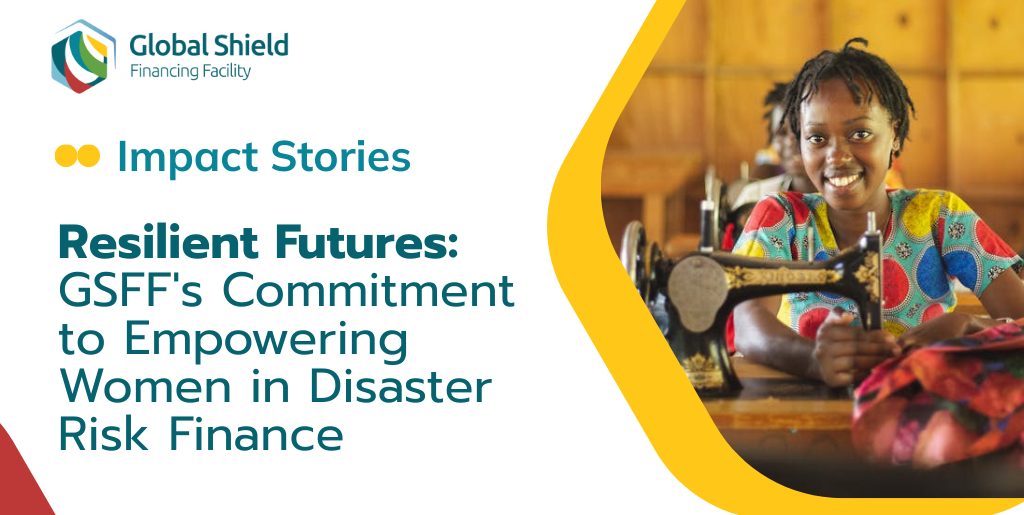The Global Shield Financing Facility's Commitment to Empowering Women in Disaster Risk Finance

Systematically including women in CDRFI holds tremendous potential for protecting and enhancing their economic participation. Recognizing this, GSFF developed a Gender Strategy in 2023 to provide a foundation for a systematic and results-focused approach to integrating women in GSFF-funded activities. The strategy maps out GSFF’s high-level approach to incentivizing teams and clients to scale up the inclusion of women in designing and implementing CDRFI initiatives.
GSFF’s Gender Strategy includes four objectives:

ACHIEVEMENTS
Gender considerations embedded in grant approval process: GSFF incorporates targeted questions in its grant proposal template, requiring teams to investigate potential gaps in the inclusion of women relevant to project scope and suggest activities to narrow them. Proposals are reviewed by a gender specialist who provides feedback. Dedicated M&E indicators have been developed and are being piloted to track the inclusion of women.
New resources: GSFF has developed resources for CDRFI practitioners, including a guidance note that provides hands-on guidance to practitioners on how to incorporate considerations on the inclusion of women into CDRFI interventions and measure results. Accompanying the guidance note are three case studies that illustrate how these aspects were considered in three CDRFI projects, and appropriate activities developed, implemented and monitored: “DRIVE in the Horn of Africa,” “Lesotho Competitiveness and Financial Inclusion Project,” and the “Third Northern Uganda Social Action Fund” project.
Training module: A training module, “Gender and Disaster Risk Finance: Starting the Conversation,” developed and designed by the GSFF gender team, raises awareness of considerations related to women's inclusion in CDRFI and equips teams with relevant resources. The module was piloted at Georgetown University in February 2024.
Collaboration with Insuresilience Global Partnership's Centre of Excellence on Gender-Smart Solutions: GSFF collaborates with the InsuResilience Global Partnership’s Centre of Excellence on Gender-Smart Solutions by providing technical expertise and participating in knowledge exchange. This work includes peer-reviewing guides and policy papers, contributing to capacity-building approaches, and participating in webinars such as the “Confronting Challenges in Gender-Smart Climate and Disaster Risk Finance” event held in May 2024.
Advisory support to task teams: Project teams working on GSFF-financed projects receive targeted support from GSFF’s gender team, which advises on incorporating considerations related to women inclusion into emerging CDRFI initiatives.
For example, hands-on advisory support is provided to the Bangladesh project team. Under the CDRFI component of the Bangladesh Jamuna River Sustainable Management Project, a diagnostic and scoping exercise is assessing protection gap across selected sites in the Jamuna River, in part to inform targeting of emergency assistance and ensuring adequate coverage of women. The exercise also examines how women are considered in the design of current programs operating in the selected target sites. Direct advisory support to operations on these issues is nascent and will be expanded in FY25. Special emphasis will be placed on guiding teams in designing and implementing CDRFI-relevant gender activities that will enhance CDRFI bank operations and contribute to targets on women's inclusion set under the new World Bank Group Corporate Scorecard.
The DRIVE project incorporates a four-year quasi experimental evaluation—the first of its kind for a large-scale World Bank–funded DRFI project—to investigate the impact of a financial services package offered under the project in Ethiopia and Kenya. Research design and evaluation questions include women-specific angles to probe preferences and beliefs, demand, information sharing and uptake, insurance decisions, and intra-household dynamics. A GSFF gender expert is serving as part of the DRIVE implementation team to inform, expand, and extract lessons from the intervention’s gender targeting. A workshop held in June 2024 that discussed findings from the DRIVE impact evaluation looked at women targeting and its effect on knowledge and trust in the program and products.
In Lesotho, the GSFF-supported MSME resilience window being developed will account for gender in the eligibility criteria and will establish targets to ensure MSMEs owned by women receive relief funds in the event of shocks. Analytical products, including the national CDRFI strategy, the value for money analysis, and the MSME Resilience Fund Handbook, all take gender-specific impacts into account

Photo: Govati Nyirenda/World Bank
IMPACT HIGHLIGHTS
In Burkina Faso, micro, small and medium enterprises (MSMEs) will benefit from expanded access to finance, including the country’s 10 percent of businesses owned by women.
In Sierra Leone, emergency cash transfers target households headed by women, the elderly, and persons with disabilities. In total, 71 percent of program beneficiaries are female.
In Lesotho, the Ministry of Gender, Youth, and Social Development is a core member of the new CDRFI Technical Working Group and will help ensure gender considerations are reflected in all relevant strategies and activities. Among other project activities, women will receive financial literacy and digital payments training.
In Pakistan, where women make up 45 percent of the active borrower base in the microfinance sector, the requirement that microfinance lenders meet gender-focused criteria when on-lending will expand women’s access to financial resources.
In Southern Africa, 2,500 women-led MSMEs will receive financial literacy training and benefit from national gender-informed emergency response plans being developed.


